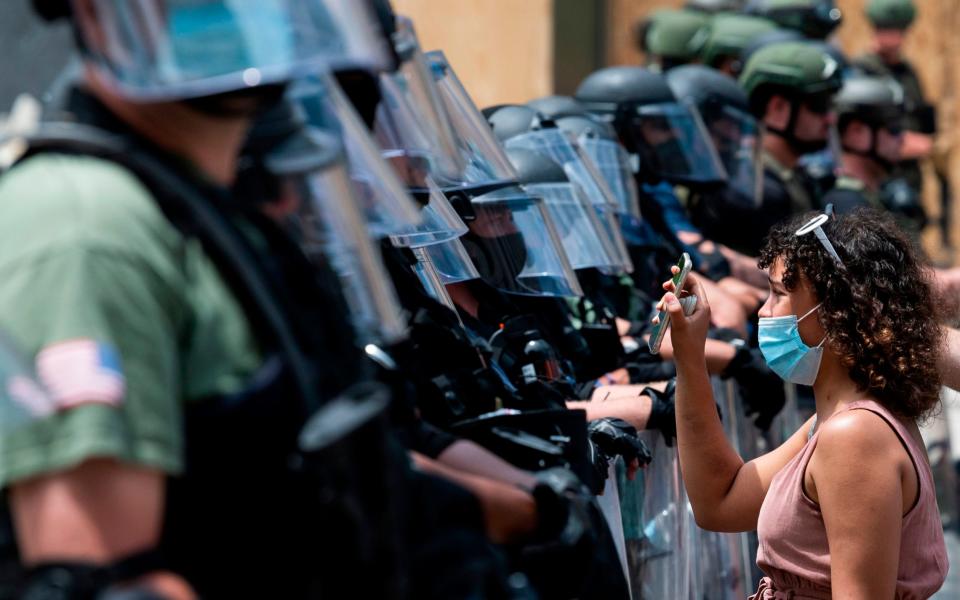How ubiquitous camera phones are helping and hurting US protesters

Anyone spending time on social media this week could not have missed the fact that protests are happening across the US and the world against police violence towards black people.
Video after video, often shot by protesters or citizen journalists, show police charging, tear gas being thrown, protesters chanting and marching and also the scenes of chaos that have followed protests in some cities, including looting, vandalism and fires.
This endless procession of footage is overwhelming but it is also useful. While misinformation is easy to spread, it is hard to fake footage. “Trust me… If we didn’t have cameras… This would ALL be denied,” tweeted the US musician and record producer Ice T on Tuesday.
But there is also an ethical tension between the undoubted benefit of having evidence and witnesses, and protesters' concerns that being caught on camera could put their lives at risk.
Filming the police in America is a right enshrined in law. But videos from the past few days show TV cameras, photographers and people simply filming with smartphones not just being caught in the crossfire but being actively targeted by police.
Trust me… If we didn’t have cameras… This would ALL be denied.
— ICE T (@FINALLEVEL) June 2, 2020
Arguably, the protests would not be happening at all without smartphone cameras. The visceral nature of the widely-circulated video showing George Floyd’s death under the knee of a Minneapolis police officer - originally livestreamed on Facebook - has undoubtedly spread the cause to others who might otherwise have been sceptical or unaware.
A black woman, Breonna Taylor, who was killed by police while asleep in her own home, has also been a cause for protesters, but her case has not been as front-and-centre as that of Mr Floyd, something some commentators have suggested is down to the fact that there is no video of the incident.
The US author and journalist Ta-Nehisi Coates said in a speech in 2015: “It’s the cameras that are new. It’s not the violence that’s new.”
Videos such as that showing Mr Floyd’s death help to spread the message. But they have also been criticised for turning the deaths of black people into a form of entertainment.
A series of black men and boys have had their deaths captured on camera, including Eric Garner, Walter Scott, Philando Castile, 12-year-old Tamir Rice, and most recently Ahmaud Arbery, a Georgia jogger who was killed by a white father and son in February.
“We are now inundated with footage. I saw a cable news network with multiple screens showing different shootings all at once — a high definition wall of black death,” Melanye Price, professor of political science at Prairie View A&M University in Texas, wrote in the New York Times on Wednesday.
There are also ethical issues with filming at protests. The rise of the camera phone has led to more documentary evidence than ever before, and human rights groups warn that it can be used by law enforcement, even against peaceful protesters.
In London, videos have also been posted online by those opposed to the protests, focusing on the vandalism and scuffles with police involving a few demonstrators.
Sam Gregory, of the US organisation Witness, which helps people capture human rights abuses on camera, said: “The fact that more people are filming is a good thing overall, because having multiple angles helps challenge someone claiming something is falsified, and it can help show in an investigation how force happened.
“We do a lot of work with people training them to work in teams at protests so that you can show different angles, show the context.
“So it's good that people are filming. I think the place to be careful is the assumption that sharing is always a good thing, particularly if you are not paying attention to these privacy and safety concerns.”
Witness once had to give out camera equipment to activists to allow them to document rights violations. Now everyone has a smartphone, and their work focuses more on teaching people to film and photograph safely.
Mr Gregory says protest leaders have been threatened by white supremacists and that police and authorities, including US immigration agency ICE, are known to comb the footage for evidence that could be used against people.
He suggests trying to avoid filming people’s faces, asking people for permission before filming them, and considering blurring out visible faces or tattoos when posting on social media, all practices which go above and beyond the usual requirements for legally filming people in public places.
In some cases, such as in that of Freddie Gray, a 25-year-old killed in Baltimore police custody in 2015, witnesses who film an arrest or assault also end up getting arrested without any other cause.
Police departments across the US, the FBI, US drug enforcement agency the DEA, and ICE all have contracts with Clearview AI, the controversial facial recognition startup which lets clients comb the web for images of people they are interested in.
Livestreams, which have appeared on YouTube and on gaming site Twitch, are a particular concern, because they give the authorities a minute-by-minute account of what protesters are doing, and are difficult to anonymise.
Face masks, common across the US because of the Covid-19 pandemic, already frustrate facial recognition software. Tech companies are also responding. On Thursday privacy-forward messaging app Signal announced a face-blurring tool which automatically detects faces in images and blocks them out.
The company’s co-founder Moxie Marlinspike, announcing the new feature, said he wanted to support the protesters using the app to organise. “2020 is a pretty good year to cover your face,” he said.

